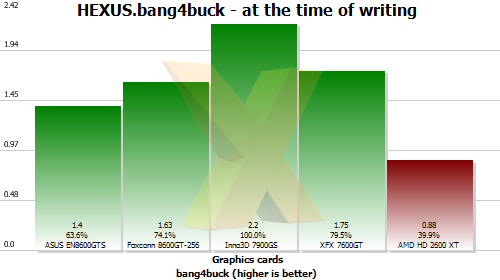Bang4buck and overclocking
The HEXUS.bang4buck test takes the benchmark scores from the previous tests, performs some mathematical magic and gives us a nice at-a-glance comparison of the relative performance of the cards on test.
This analysis does not take into account extra features - neither video decoding nor DirectX 10 tests are part of our benchmarking suite as yet. So these factors must be taken into consideration separately.
| Graphics card | ASUS EN8600GTS | Foxconn 8600GTS-256 | Inno3D iChiLL 7900GS Arctic Cooling Silencer 6 | XFX Fatal1ty 7600GT 256MB GDDR3 | AMD Radeon HD 2600 XT 256MB GDDR4 |
|---|---|---|---|---|---|
| Actual aggregate marks at 1280x1024 4xAA 8xAF | 184.75 | 163.94 | 263.87 | 170.33 | 114.34 |
| Aggregate marks, normalised, at 1280x1024 | 174.68 | 152.29 | 221.94 | 151.91 | 81.51 |
| Price | £124 | £93 | £109.95 | £86.67 | £92.81 (PowerColor-brand) |
| HEXUS.bang4buck score | 1.4 | 1.63 | 2.019 | 1.753 | 0.878 |
| Acceptable frame rate (Av. 60FPS) at 1280x1024 4xAA 8xAF | No (FC and SC) | No (FC and SC) | Yes | No (FC and SC) | No (All tests) |

Once again, the previously-reviewed Inno3D iChiLL 7900GS Arctic Cooling Silencer 6 comes top of the bang4buck results.
The reason is fairly easy to see, too. The 7900GS is a high-end GPU scaled down to the mid-market. In contrast, its competitors are designed for the mid-market from the outset.
NVIDIA would no doubt prefer you buy an 8600-based part, rather than the 7900GS, because the G71 on which the 7900GS is based is a comparatively large piece of silicon that was priced down into this market space. So, NVIDIA's profit margin on a 7900GS chip will most likely be considerably lower.
[advert]Ultimately, though, even the 7600GT offers better value than the ASUS or the Foxconn by virtue of offering better performance and a lower price-tag.
The AMD Radeon HD 2600 XT will hopefully improve as drivers mature but, for now, it's firmly in last place.
Overclocking
The ASUS EN8600GTS was able to reach a maximum speed of 725MHz for the GPU core and 2238MHz for the memory.That's hardly spectacular considering the XFX GeForce 8600 GTS XXX Edition we looked at recently came clocked higher than this as standard - and the ASUS's memory clocks are the lowest of any 8600GTS we've tested so far, indicating that it was indeed held back by the lack of heat-sinks on its memory chips.
With the Foxconn, we were able to reach 616MHz on the core and 1702MHz for the memory. Those are useful increases over stock but won't set the world alight given how much slower they are even than the GTS at stock speeds.

The Foxconn's overclocked results place it around halfway between its own stock result and that of the ASUS.









